外科病理学实践:诊断过程的初学者指南 | 第22章 肺
第22章 肺(Lungs)
正常组织学(Normal Histology)
The lungs consist of principally four compartments: the large airways(bronchi), small airways and airspaces(bronchioles and alveoli), interstitium, and vessels. As in most organs, inflammatory processes tend to preferentially involve one or two compartments, so identifying the most affected area is key to the differential diagnosis. Normal histologic features include the following:
肺主要由四个部分组成:大气道(支气管)、小气道和气腔(细支气管和肺泡)、间质和血管。与大多数器官一样,炎症过程往往优先累及一个或两个部分,因此确定最受影响的区域是鉴别诊断的关键。正常组织学特征包括:
Bronchi: The bronchi are lined with ciliated or columnar epithelium with scattered goblet cells. Goblet cell metaplasia is an indication of irritation, such as in bronchitis or asthma. Squamous cell metaplasia is common in smokers. Under the epithelium you should find seromucinous(salivary-type) glands, cartilage, smooth muscle, and branches of the bronchial arteries(Figure 22.1).
支气管:支气管内衬纤毛上皮或柱状上皮,有散在的杯状细胞。杯状细胞化生提示受到刺激,如支气管炎或哮喘。鳞状细胞化生常见于吸烟者。在上皮下,你会发现浆粘液性(涎腺型)腺体、软骨、平滑肌和支气管动脉分支(图22.1)。
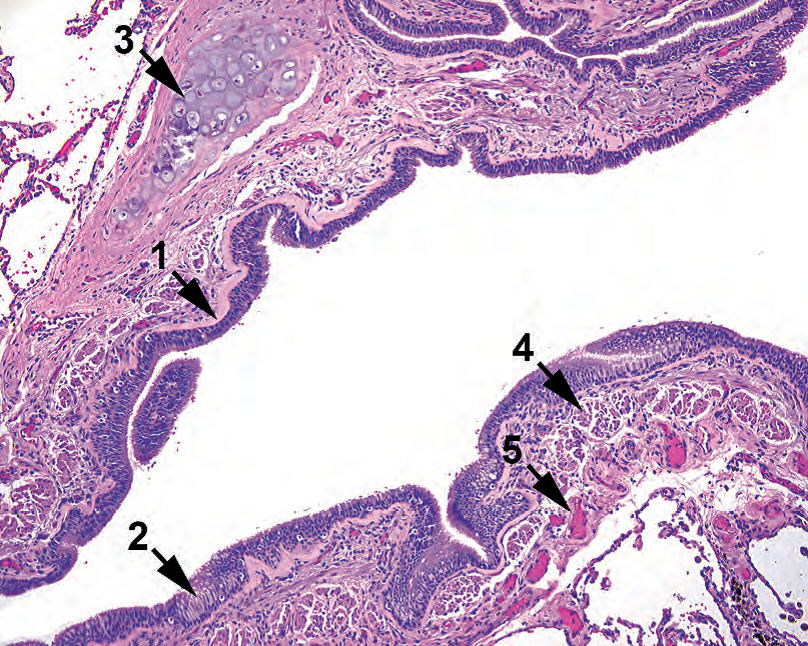
Figure 22.1. Normal bronchus. The bronchus is lined by ciliated columnar epithelium(1), foci of goblet cells(2), cartilage(3), and smooth muscle(4). The small arteries seen here(5) are branches of the bronchial artery, which carries oxygenated blood from the left ventricle.
图22.1 正常支气管。支气管由纤毛柱状上皮(1)、小灶杯状细胞(2)、软骨(3)和平滑肌(4)构成。这里所见的小动脉(5)是支气管动脉的分支,它从左心室输送含氧血液。
Bronchioles: Bronchioles should have a cuboidal epithelium without goblet cells(Figure 22.2). The Clara cells are probably secretory and reserve cells, but they are difficult to see. There is no cartilage.
细支气管:细支气管应有立方上皮,无杯状细胞(图22.2)。Clara细胞可能是分泌细胞和储备细胞,但很难看到。没有软骨。
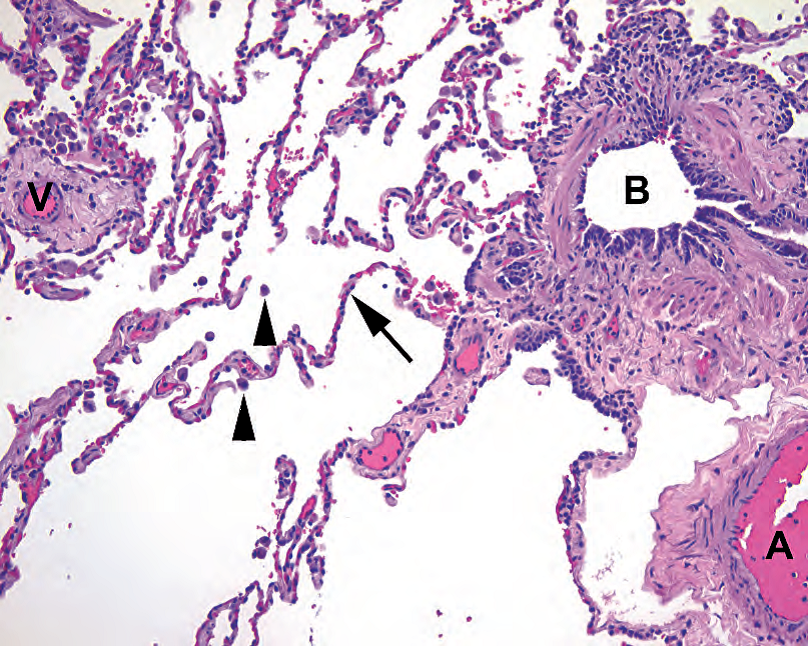
Figure 22.2. Bronchioles and alveoli. The small bronchiole(B) seen here is lined by a cuboidal epithelium and smooth muscle. The large adjacent arteriole(A) is a branch of the pulmonary artery. The veins or venules(V) run in septa. The alveolar walls(arrow) are normally lined with flat type I epithelium, of which only the nuclei are visible. Alveolar macrophages(arrowheads) are common.
图22.2 细支气管和肺泡。小细支气管(B)有立方上皮和平滑肌排列。相邻的小动脉(A)是肺动脉的分支。静脉或小静脉(V)位于肺泡隔中。肺泡壁(箭)通常被覆平坦的I型上皮,只看到核。常见肺泡巨噬细胞(箭头)。
Alveoli: The alveoli are the terminal air sacs and therefore have extremely thin walls(see Figure 22.2); in atelectasis, a common biopsy artifact, it is difficult to pick out the collapsed airspaces. Normally they are lined by nearly invisible flat type I epithelium. The presence of a cuboidal epithelium indicates type II hyperplasia(surfactant and reserve cells, which are normally sparse), seen in chronic inflammation or repair. Alveolar macrophages are often scattered throughout but macrophages packing the alveoli is pathologic(see later discussion of desquamative interstitial pneumonia).
肺泡:肺泡是终末气囊,因此非常薄壁(见图22.2);肺不张是一种常见的活检假象,很难识别塌陷的气腔。正常情况下,它们被覆几乎看不见的扁平I型上皮。出现立方上皮提示II型增生(表面活性剂和储备细胞,通常稀疏),见于慢性炎症或修复。肺泡巨噬细胞通常散布于肺泡各处,但聚集在肺泡内的巨噬细胞是病理性的(见下文关于脱屑性间质性肺炎的讨论)。
Vessels: Pulmonary arterioles run with bronchioles and have two elastic layers on Movats stain(train track appearance). Veins run in interlobular septa and have one irregular elastic lamina. Lymphatics run with arteries, veins, and in pleura.
血管:肺小动脉与细支气管一起运行,在Movats染色上有两层弹性层(火车轨道外观)。静脉在小叶间隔内运行,有不规则的弹性层。淋巴管与动脉、静脉并行,胸膜也有淋巴管。
Movats stain is a standard supplemental stain for nonneoplastic lung. On this pentachrome stain, you will see elastic laminae highlighted as black fibers(useful for identifying pleural involvement by tumors as well), hyaluronic acid or mucin in aqua blue, mature collagen in yellow, smooth muscle in dull red, and fibrinoid necrosis(as in vessels) as bright red(Figure 22.3). This stain is very useful for identifying fibroblast foci in bronchiolitis obliterans–organizing pneumonia(discussed later) because they stand out as turquoise swirls on low power. Established interstitial fibrosis will be yellow.
Movats染色是非肿瘤性肺的标准补充染色。在这个五颜六色染色上,你会看到弹力层突出显示为黑色纤维(也有助于识别肿瘤累及胸膜),透明质酸或粘蛋白呈水蓝色,成熟胶原呈黄色,平滑肌呈暗红色,纤维蛋白样坏死(如血管)呈鲜红色(图22.3)。这种染色对于鉴别闭塞性细支气管炎的成纤维细胞灶非常有用——机化性肺炎(稍后讨论),因为它们在低倍镜下呈青绿色漩涡状突出。已确定的间质纤维化呈黄色。

Figure 22.3. Movats stain. The pulmonary arteries(A) have two elastic layers(arrowheads), while the veins(V) have one(arrow). The collagen lining the vessels is pale yellow-green in this stain.
图22.3 Movats染色。肺动脉(A)有两层弹性层(箭头),而静脉(V)有一层弹性层(箭)。血管内壁的胶原呈淡黄绿色。
非肿瘤性肺简介(A Brief Introduction to Nonneoplastic Lung)
(译注:这部分内容了解即可,作者前面说过初学者不要乱搞非肿瘤的东西)
In nonneoplastic lung, within each of the four compartments you are usually looking for something that does not belong. Examples of things that do not belong include heavy mononuclear cell infiltrates(lymphocytes and macrophages), neutrophils(other than in capillaries), eosinophils, granulomas, fibrosis and fibroblast foci, and substances such as amyloid, edema fluid, and asbestos. Table 22.1 lists differential diagnoses organized by what you see and in which compartment.
非肿瘤性肺,四个组成部分中的每一个,你通常都要寻找本来没有的东西。多出来的东西,例如,严重的单个核炎症细胞浸润(淋巴细胞和巨噬细胞)、中性粒细胞(除外毛细血管内)、嗜酸性粒细胞、肉芽肿、纤维化和成纤维细胞灶,以及淀粉样物、水肿液和石棉等物质。表22.1根据你看到什么和在哪个部分列出鉴别诊断。
Table 22.1. Differential diagnoses.
表22.1 鉴别诊断。
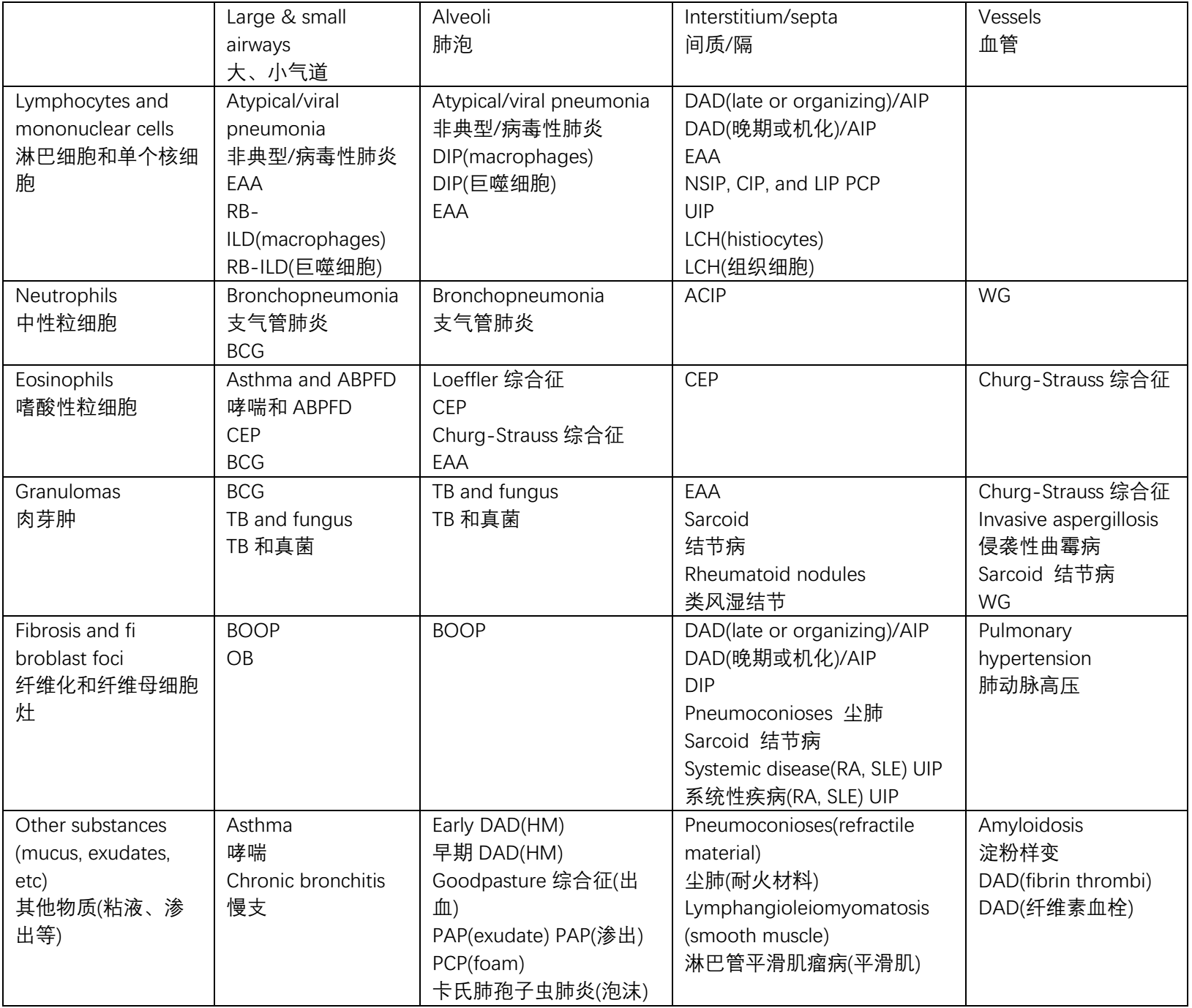
ABPFD, allergic bronchopulmonary fungal disease过敏性支气管肺真菌病; ACIP, active chronic interstitial pneumonitis活动性慢性间质性肺炎; AIP, acute interstitial pneumonitis急性间质性肺炎; BCG, bronchocentric granulomatosis支气管中心性肉芽肿; BOOP, bronchiolitis obliterans–organizing pneumonia闭塞性细支气管炎-机化性肺炎; CEP, chronic eosinophilic pneumonia慢性嗜酸性肺炎; CIP, chronic interstitial pneumonia慢性间质性肺炎; DAD, diffuse alveolar damage弥漫性肺泡损伤; DIP, desquamative interstitial pneumonia脱屑性间质性肺炎; EAA, extrinsic allergic alveolitis(hypersensitivity pneumonitis)外源性过敏性肺泡炎(过敏性肺炎); HM, hyaline membranes透明膜; LCH, Langerhans cell histiocytosis朗格汉斯细胞组织细胞增生症; LIP, lymphocytic interstitial pneumonia淋巴细胞性间质性肺炎; NSIP, nonspecific interstitial pneumonia非特异性间质性肺炎; OB, obliterative bronchiolitis闭塞性细支气管炎; PAP, pulmonary alveolar proteinosis肺泡蛋白沉积症; PCP, Pneumocystis carinii pneumonia卡氏肺孢子虫肺炎; RA, rheumatoid arthritis类风湿性关节炎; RB-ILD, respiratory bronchiolitis-interstitial lung disease呼吸性细支气管炎-间质性肺病; SLE, systemic lupus erythematosus系统性红斑狼疮; TB, tuberculosis结核病; UIP, usual interstitial pneumonia普通间质性肺炎; WG, Wegener’s granulomatosis韦格纳肉芽肿
对肺损伤的反应(Response to Injury in the Lung)
It is useful to think of the three phases of injury response in the lung: acute, subacute, and chronic. Acute injury, which may be from infection, trauma, toxins, drugs, or a transfusion reaction, manifests as diffuse alveolar damage. Clinically this pattern correlates with acute respiratory distress syndrome. Idiopathic diffuse alveolar damage, when no known precipitating factor can be identified, is called acute interstitial pneumonitis. The histologic picture is a nonspecific indication of injury and includes interstitial edema and hemorrhage, hyaline membrane formation, type II hyperplasia, and fibrin thrombi(Figure 22.4). There should be a uniform and diffuse appearance throughout the field of view(although it may be patchy grossly).
把肺损伤反应分为三个阶段是有用的:急性、亚急性和慢性。急性损伤可能是由于感染、创伤、毒素、药物或输血反应,表现为弥漫性肺泡损伤。临床上,这种模式与急性呼吸窘迫综合征相关。特发性弥漫性肺泡损伤,当没有已知的促发因素时,称为急性间质性肺炎。组织学图像是损伤的非特异性表现,包括间质水肿和出血、透明膜形成、II型增生和纤维素血栓(图22.4)。在整个视野范围内,应具有均匀且分散的外观(尽管肉眼观可能呈斑点状)。
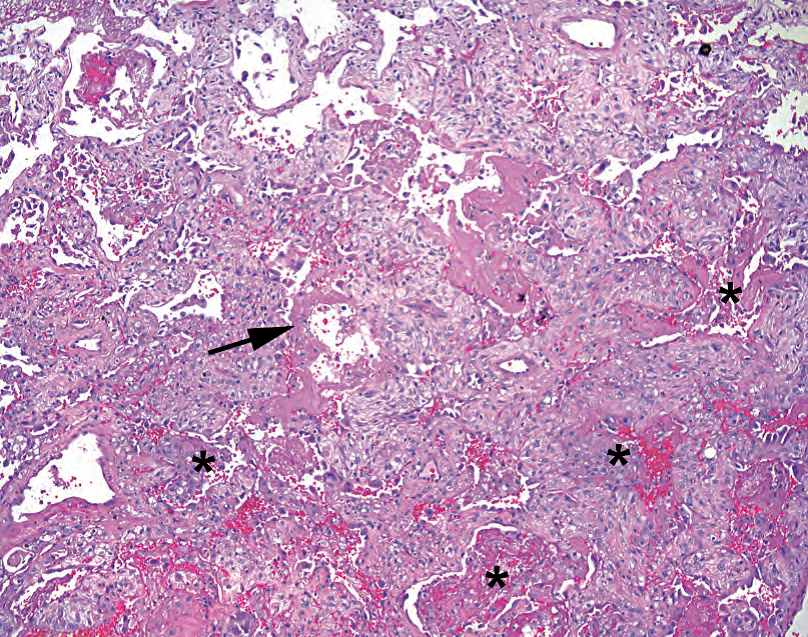
Figure 22.4. Diffuse alveolar damage. The alveolar spaces are full of fluid and blood(asterisk), which in some areas is beginning to coalesce into thick pink hyaline membranes(arrow). The interstitial spaces are thickened due to edema.
图22.4 弥漫性肺泡损伤。肺泡腔充满液体和血液(星号),在某些区域,这些液体和血液开始合并成厚的粉红色透明膜(箭头)。由于水肿,间质增厚。
When the initial injury begins to resolve, you see the organizing phase, which consists of new fibroblast foci forming in alveoli and bronchioles. These are the swirling nodules of stellate fibroblasts that appear myxoid on H&E stain and aqua on Movats stain(Figure 22.5). They are also the hallmark of bronchiolitis obliterans–organizing pneumonia(BOOP), the pattern of subacute injury response. It can be impossible to distinguish a primary BOOP from a resolving acute injury without the clinical context. It is also seen as a component of many other disease processes, but as a primary disease it is simply “idiopathic BOOP.” Obliterative bronchiolitis is a related lesion that is really only seen in transplant patients, and is a form of either rejection or graft-versus-host disease.
当最初的损伤开始消退时,你会看到机化阶段,表现为肺泡和细支气管中新生的成纤维细胞灶。成纤维细胞灶是星形成纤维细胞形成的漩涡状结节,HE染色呈黏液样,Movats染色呈蓝绿色(图22.5)。成纤维细胞灶也是闭塞性细支气管炎的特征,称为机化性肺炎(BOOP),属于亚急性损伤反应模式。在没有临床背景的情况下,不可能区分原发性BOOP和消退期急性损伤。机化性肺炎也是许多其他疾病过程的一个组成部分,但作为一种原发性疾病,它只是“特发性BOOP”。闭塞性细支气管炎是一种相关病变,仅见于移植患者,是排斥反应或移植物抗宿主病的一种形式。
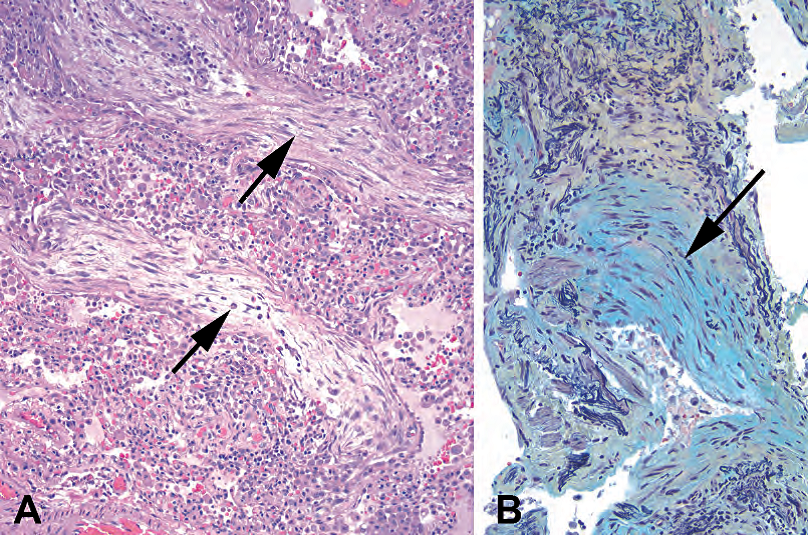
Figure 22.5. Fibroblast foci.(A) By H&E stain, these myxoid swirls of new fibroblasts are pale and streamy(arrows).(B) On Movats stain, they are turquoise(arrow).
图22.5 成纤维细胞灶。(A)HE染色,这些新生的成纤维细胞形成黏液样漩涡,呈淡染的流水样排列(箭)。(B)Movats染色呈蓝绿色(箭头)。
Chronic and repetitive injury to the lung is like a scab on the skin that gets repeatedly picked off; there are multiple cycles of damage and repair, and the end result is chronic inflammation and fibrosis. The final common pathway of many diseases, or end-stage lung, is called honeycomb lung. A specific pattern of chronic injury that may lead to honeycomb lung is usual interstitial pneumonia. Usual interstitial pneumonia is a nonspecific pattern; idiopathic pulmonary fibrosis is the name given to idiopathic usual interstitial pneumonia.
肺部的慢性和重复性损伤就像皮肤的结痂,被反复剥落;有损伤和修复的多个周期,最终结果是慢性炎症和纤维化。许多疾病的最终共同途径,或终末期肺,称为蜂窝状肺。一种可能导致蜂窝状肺的特殊慢性损伤模式是普通间质性肺炎。普通间质性肺炎是一种非特异性模式;特发性普通间质性肺炎又称为特发性肺纤维化。
Usual interstitial pneumonia should be temporally heterogenous, which means you should see evidence of all stages of injury(acute, subacute, and chronic). There is prominent interstitial fibrosis, which outlines large and angular distorted airspaces(Figure 22.6), but there should also be fibroblast foci. The airspaces are lined by plump, reactive, and scary looking type II pneumocytes. There is diffuse chronic inflammation, as well as pockets of acute inflammation.
普通间质性肺炎应该表现为暂时的异质性,这意味着你应该看到所有损伤阶段(急性、亚急性和慢性)的证据。有明显的间质纤维化,它勾勒出大而成角的扭曲的气腔(图22.6),但也应该有成纤维细胞灶。这些气腔被覆着丰满的、反应性、看起来吓人的II型肺泡细胞。有弥漫性慢性炎症,也有局部急性炎症。

Figure 22.6. Usual interstitial pneumonia. The interstitial spaces are thickened and fibrotic(arrowhead), and there is abundant chronic inflammation(arrow). Inset: The scarred down, irregularly shaped, residual alveolar spaces are lined with type II pneumocytes, which protrude into the lumen and may have atypical nuclei.
图22.6 普通间质性肺炎。间质增厚、纤维化(箭头),有大量慢性炎症(箭)。插图:类似结痂的、形状不规则的残余肺泡腔衬覆II型肺泡细胞,这些细胞伸入管腔,可能有非典型核。
过敏性疾病(Allergic Disease)
There are two forms of allergic response in the lung: IgE-mediated disease and cell-mediated hypersensitivity reactions. Diseases in the first category include asthma, allergic bronchopulmonary fungal disease, bronchocentric granulomatosis(allergy to Aspergillus), and the eosinophilic pneumonias.
肺中有两种形式的过敏反应:IgE介导的疾病和细胞介导的超敏反应。前者包括哮喘、过敏性支气管肺真菌病、支气管中心性肉芽肿(对曲霉菌过敏)和嗜酸性肺炎。
The prototypical cell-mediated hypersensitivity disease is extrinsic allergic alveolitis. It can have many causes and many appearances. This includes all the “(undesirable-job-here)’s lung” and “(exotic-pet-name) fancier’s lung” diseases(e.g., “formalin lung” and “lizard-lover’s lung”). Eosinophils do not feature prominently in extrinsic allergic alveolitis. The classic histologic triad includes(1) patchy chronic interstitial pneumonia, especially peribronchiolar;(2) poorly formed small nonnecrotizing granulomas; and(3) foci of BOOP.
后者典型疾病是外源性过敏性肺泡炎。它可能有许多原因和许多形态表现。包括所有的“不受欢迎的工作”的肺和“异国情调的宠物名”爱好者的肺“疾病(例如,“福尔马林肺”和“蜥蜴爱好者的肺”)。嗜酸性粒细胞在外源性过敏性肺泡炎中不是主要特征。典型的组织学三联征包括:(1)斑片状慢性间质性肺炎,尤其是细支气管周围;(2)不完好的非坏死性小肉芽肿;局灶BOOP。
吸烟者疾病(Diseases of Smokers)
Smokers get a spectrum of interstitial lung diseases, including desquamative interstitial pneumonitis(DIP), respiratory bronchiolitis, Langerhans cell histiocytosis, and probably usual interstitial pneumonia. They also get obstructive lung disease, which includes chronic bronchitis and emphysema. DIP is a disease process in which alveolar macrophages pack the alveoli; it is usually associated with smoking, but a DIP pattern may be seen in other processes as well.
吸烟者患有一系列间质性肺病,包括脱屑性间质性肺炎(DIP)、呼吸性细支气管炎、朗格汉斯细胞组织细胞增生症,可能还有普通间质性肺炎。他们还患有阻塞性肺病,包括慢性支气管炎和肺气肿。DIP是肺泡巨噬细胞充满肺泡的疾病过程;它通常与吸烟有关,但其他疾病也可能会出现DIP模式。
Note that Langerhans cell histiocytosis, also called eosinophilic granuloma, does not have traditional granulomas and may not always have eosinophils. What it does have is collections of histiocytes, identified by their pale nuclei with folds and creases(or by immunostains). This disease may occur systemically in the pediatric population, but in adults(which are 50% of cases) it is an isolated pulmonary disease of smokers.
注意,朗格汉斯细胞组织细胞增生症,也称为嗜酸性肉芽肿,没有传统的肉芽肿,也可能不总是有嗜酸性粒细胞。它具有组织细胞聚积,组织细胞核淡染并有皱折和折痕,或通过免疫染色来识别。这种疾病可见于儿科患者的系统性疾病,但在成人(占50%)中,它是吸烟者的一种孤立性肺部疾病。
肿瘤性肺(Neoplastic Lung)
异型增生与原位癌(Dysplasia and Carcinoma In Situ)
The terms dysplasia and carcinoma in situ are not often used in pulmonary pathology. There are at least two types of epithelium that can be evaluated, the respiratory(columnar) and the squamous metaplastic. For the respiratory epithelium, the presence of cilia is a reassuring sign that all is well(Figure 22.7). However, chronically injured or irritated airspaces can get type II cell hyperplasia. On the slide, this appears as plump cuboidal to columnar eosinophilic cells, with enlarged nuclei, lining the airspaces. If this occurs as a prominent change within a small focus(less than 10 mm), it is analogous to dysplasia and is called atypical adenomatoid hyperplasia(Figure 22.8). Presumably these foci can go on to become bronchioloalveolar carcinoma, which is essentially adenocarcinoma in situ. Like dysplasia in other organs, these processes can be multifocal.
术语“异型增生”和“原位癌”在肺病理学中不常用。至少有两种类型的上皮可以评估,呼吸上皮(柱状上皮)和鳞状上皮化生上皮。前者,存在纤毛是一个令人放心的迹象,表明一切正常(图22.7)。然而,慢性损伤或受刺激的气腔可导致II型细胞增生。在切片上,表现为肥硕的立方形到柱状嗜酸性细胞,核增大,突入气腔。如果这是一个小病灶(小于10mm)内的显著改变,则类似于异型增生,称为非典型腺瘤样增生(AAH,图22.8)。据推测,这些病灶可能会发展为细支气管肺泡癌,实质上是原位腺癌。与其他器官异型增生一样,这些过程可能是多灶性。
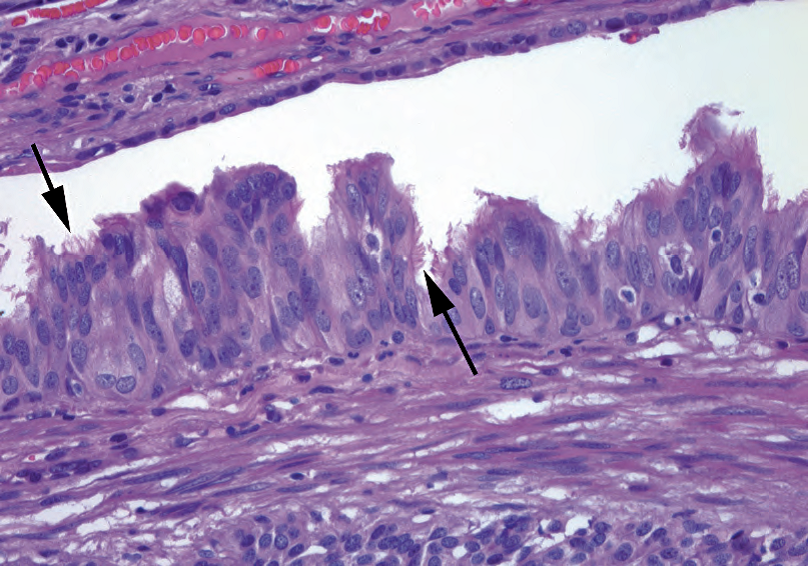
Figure 22.7. Reactive bronchial epithelium overlying a carcinoid tumor. Although the epithelium is very proliferative and has enlarged and crowded nuclei, the presence of cilia(arrows) indicates that these cells are benign.
图22.7 覆盖在类癌上方的反应性支气管上皮。尽管上皮细胞增殖非常活跃,核增大拥挤,但存在纤毛(箭头所示)提示良性。

Figure 22.8. Atypical adenomatoid hyperplasia. In this tiny, limited focus, there is interstitial inflammation(arrow) and prominent type II hyperplasia(arrowhead). The adjacent alveolar walls are unremarkable.
图22.8 非典型腺瘤样增生。在这个微小的、有限的病灶中,有间质性炎症(箭)和显著的II型增生(箭头)。相邻的肺泡壁无特殊。
For squamous epithelia, although squamous dysplasia exists and is analogous to other organs, in practice it is not often caught on biopsy. Similarly, squamous carcinoma in situ exists in the bronchi just as in the larynx or oropharynx but is usually seen at the periphery of squamous cancers instead of as the sole finding in a biopsy specimen.
对于鳞状上皮,虽然存在鳞状上皮异型增生,类似于其他器官,但实际上在活检中少见。类似地,鳞状细胞原位癌与喉或口咽一样存在于支气管,但通常见于鳞癌周围,而不是活检标本中唯一发现。
癌(Carcinoma)
Most lung biopsies in the neoplastic category are performed because a mass lesion was detected on radiology. Dysplasia and carcinoma in situ generally are not mass forming, so once you have ruled out a granulomatous process(those can form nodules), you are trying to identify the neoplasm. The most common lesions are discussed below. However, keep in mind that in lung, most tumors are a mix of tumor types or variants(pluripotent stem cells?), so you must sample well, name the tumors for their major components, and ignore small foci of different morphologies. Non–small cell is sort of a wastebasket term used to mean adenocarcinoma or squamous cell carcinoma, which can be grouped like that because their clinical behavior is similar.
大多数肿瘤类别的肺活检是因为影像学发现肿块病变。异型增生和原位癌通常不形成肿块,因此你一旦排除了肉芽肿疾病(可能形成结节),就要努力识别肿瘤。下面讨论最常见的病变。然而,要记住,肺的大多数肿瘤是多种肿瘤类型或变异型(来自多能干细胞?)的混合,因此你必须仔细取材,根据主要成分命名肿瘤,并忽略不同形态的小病灶。非小细胞癌是一个垃圾桶术语,用来指腺癌或鳞状细胞癌,因为它们的临床行为相似,所以可以这样分类。
Squamous carcinoma arises from squamous metaplasia, often in the major bronchi, and therefore is often central or hilar. The most recognizable form is the well to moderately differentiated keratinizing variety, with its pink, dense cytoplasm, keratin whorls, and distinct cell borders(Figure 22.9). It is graded on the typical well, moderately, or poorly differentiated scale. However, there are trickier variants, including the following:
鳞癌起源于鳞状化生,常发生在主支气管,因此常位于中央或肺门。最易辨认的形式是高-中分化的角化型,具有粉红色、致密的细胞质、角蛋白旋涡和清晰的细胞边界(图22.9)。一般分为高、中或低分化。然而,还有一些更为棘手的变异型,包括:
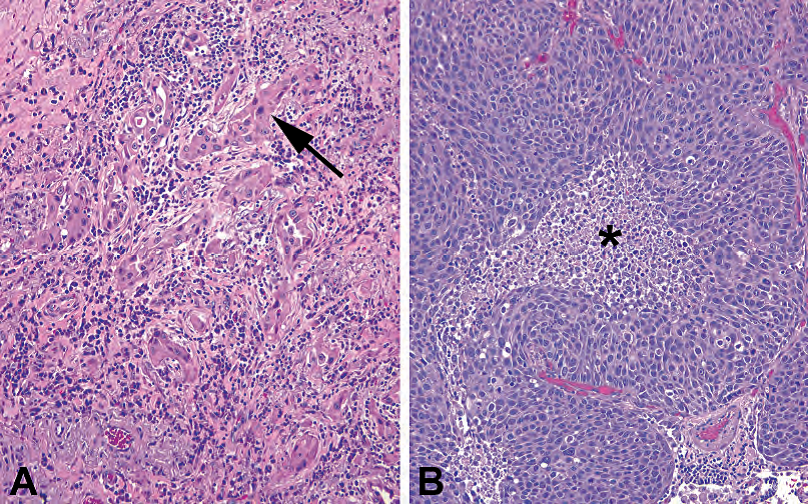
Figure 22.9. Squamous cell carcinoma.(A) Moderately differentiated squamous cell carcinoma, with irregular nests of cells with highly pleomorphic nuclei and bright pink, dense cytoplasm(arrow). Keratin pearls may also be seen in more well-differentiated tumors.(B) Basaloid squamous cell carcinoma, with rounded nests of very blue tumor cells with high nuclear to cytoplasmic ratio and a high mitotic rate. Central necrosis(asterisk) is common.
图22.9 鳞状细胞癌。(A)中分化鳞状细胞癌,细胞巢不规则,核高度多形性,胞质亮粉色、致密(箭)。角化珠也可见于分化较好的肿瘤。(B)基底样鳞状细胞癌,蓝色肿瘤细胞圆形巢,高核质比和高核分裂率。常见中央坏死(星号)。
Nonkeratinizing
非角化
Basaloid: blue and palisading, with a dense syncytial look(see Figure 22.9)
基底样:蓝色和栅栏状,紧密合胞体样(见图22.9)
Small cell: similar to small cell neuroendocrine, but with uglier nuclei and no neuroendo-crine staining
小细胞:类似小细胞神经内分泌癌,但核更丑,无神经内分泌染色
Spindle cell or sarcomatoid: densely cellular spindly pattern, resembling a sarcoma(Figure 22.10)
梭形细胞或肉瘤样:细胞密集,梭形,类似肉瘤(图22.10)
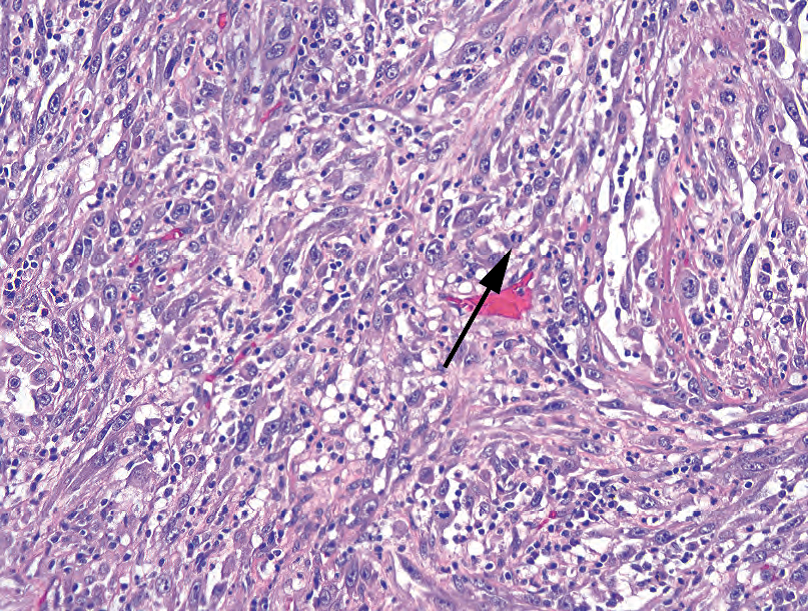
Figure 22.10. Sarcomatoid carcinoma. Sheets of spindled cells with large nuclei and prominent nucleoli are visible. Mitoses(arrow) are common. These cells should be positive for cytokeratin stains, confirming their epithelial origin.
图22.10 肉瘤样癌。成片的梭形细胞,核大,核仁显著。核分裂(箭)常见。梭形细胞应表达CK,确认其上皮来源。
Clear cell(adenocarcinoma can also have clear cells)
透明细胞(腺癌也可以有透明细胞)
Intrabronchial papillary: architecture like a papilloma, but malignant
支气管内乳头状:结构类似乳头状瘤,但恶性
Adenocarcinoma arises from multiple cell types and therefore can vary in morphology. Patterns include acinar, tubular, papillary, and solid, and they may be mucinous or nonmucinous. If you see gland formation or mucin production, it is almost certainly adenocarcinoma(Figure 22.11), and then you must decide if it is primary or metastatic.
腺癌起源于多种细胞类型,因此形态学可能有所不同。模式包括腺泡状、管状、乳头状和实性,细胞学可能是粘液性或非粘液性。如果你看到腺体形成或粘液产生,几乎肯定是腺癌(图22.11),然后你必须确定它是原发性还是转移性。
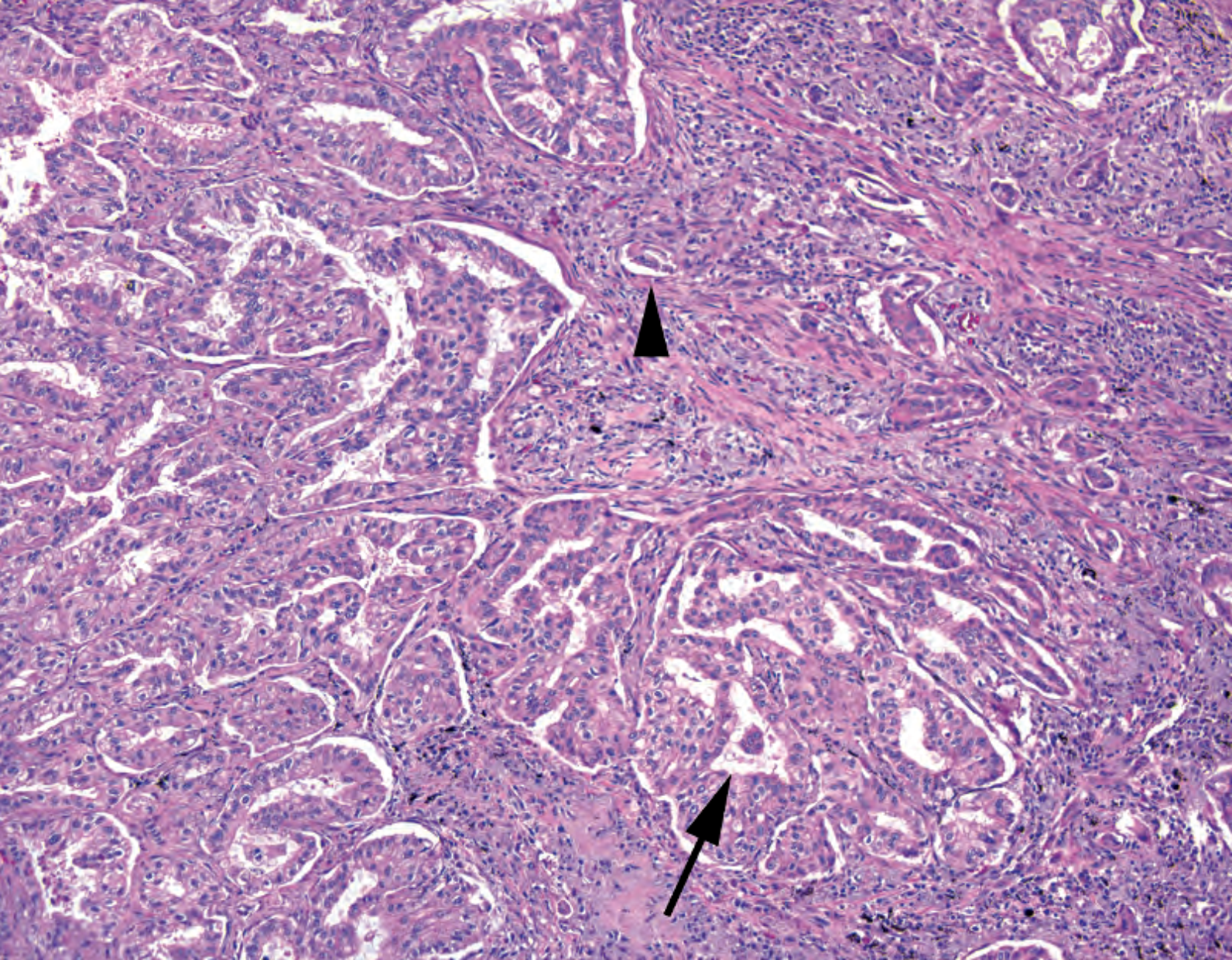
Figure 22.11. Adenocarcinoma. In some areas this tumor is forming cribriform glandular spaces(arrow), and in others small malignant glands or single cells are seen embedded in a desmoplastic stroma(arrowhead), confirming invasion.
图22.11 腺癌。在某些区域,肿瘤形成筛状腺腔(箭),其他区域,小的恶性腺体或单个细胞埋陷在促结缔组织增生的间质中(箭头),证实了浸润。
As described earlier, bronchioloalveolar carcinoma(BAC) is the in situ form of adenocarcinoma. BAC in pure form appears to have a better prognosis than other non–small cell cancers, but, surprisingly, it still behaves, and is managed like, a full-fledged carcinoma. BAC may be mucinous(probably arising from goblet cell metaplasia) or nonmucinous. Of the two, the nonmucinous type has a better prognosis and is more often solitary.
如前所述,细支气管肺泡癌(BAC)是原位腺癌。纯形BAC似乎比其他非小细胞癌的预后更好,但令人惊讶的是,它的生物学行为和治疗方式仍然像一种成熟的癌。BAC可能是粘液性(可能由杯状细胞化生引起)或非粘液性。在这两种类型中,非粘液型预后较好,且多为单发。
BAC takes the form of columnar and usually eosinophilic cells growing along the bronchial and alveolar walls, outlining the structure of the airspaces(Figure 22.12). By definition, there must not be evidence of stromal invasion(irregularly shaped back-to-back glands, single cells, desmoplasia). BAC is often found at the periphery of invasive tumors, so this diagnosis should not be made on a biopsy specimen or frozen tissue or until the entire tumor has been sampled. This rule applies to most “improved-prognosis variant” tumors in pathology: you had better not label something as a good-prognosis tumor unless the entire lesion is of that type. A “BAC pattern” refers to a growth pattern of an invasive tumor that mimics BAC.
BAC呈柱状细胞,通常嗜酸性,沿支气管和肺泡壁生长,勾画出气腔的结构(图22.12)。根据定义,不能有间质浸润的证据(不规则形状的背靠背腺体、单细胞、结缔组织增生)。BAC通常发现于浸润性肿瘤的边缘,因此不应在活检小标本或冷冻组织上进行诊断,除非对整个肿瘤进行取材。这条规则适用于病理学中大多数“预后改善的变异型”肿瘤:除非整个病变都是这种类型,否则最好不要称为预后良好的肿瘤。“BAC模式”是指假冒BAC的浸润性肿瘤的生长模式。
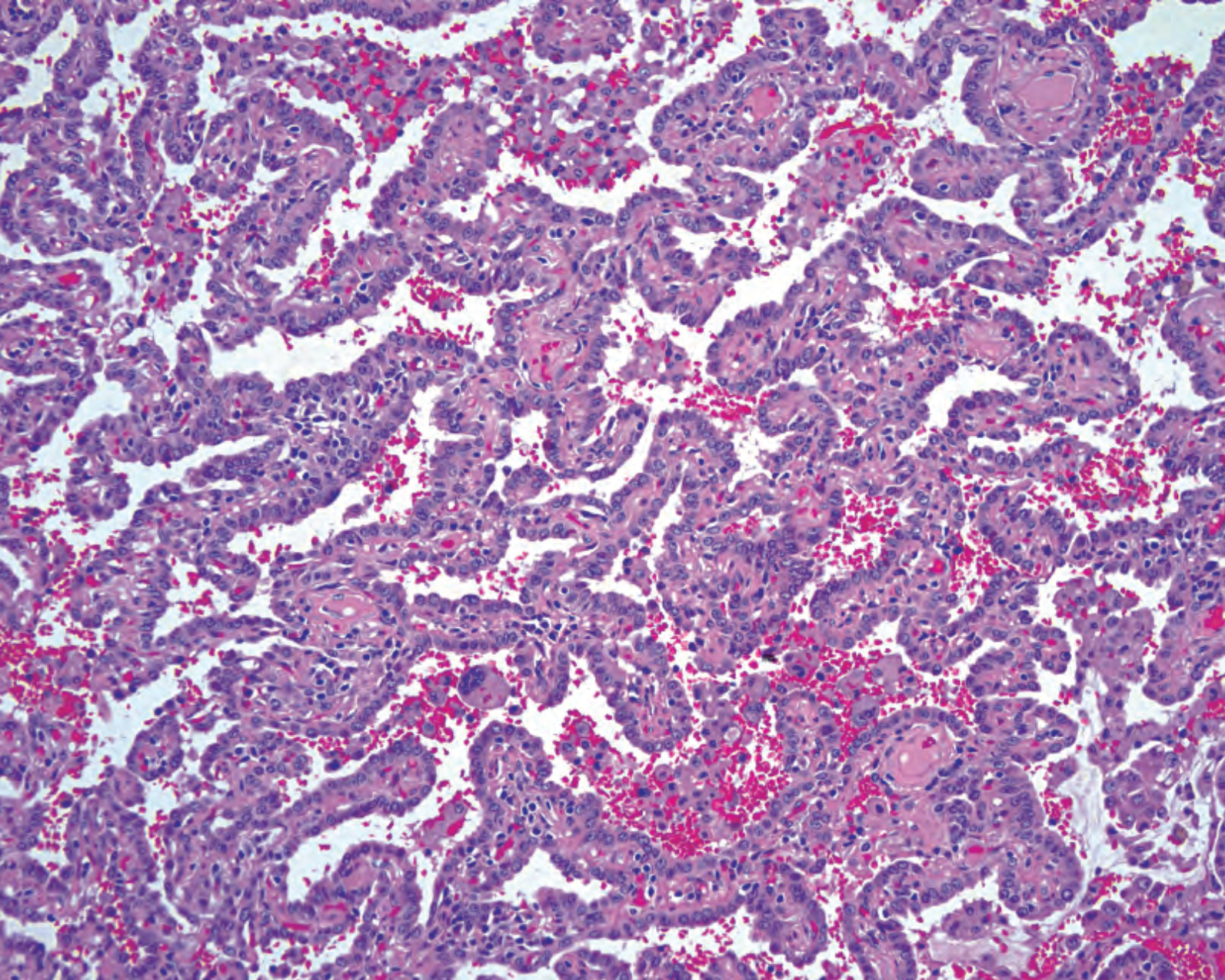
Figure 22.12. Bronchoalveolar carcinoma. The malignant cells line the alveolar walls but do not invade the stroma.
图22.12 细支气管肺泡癌。恶性细胞衬覆肺泡壁上,但不侵入基质。
Large cell undifferentiated carcinoma arises when adenocarcinoma dedifferentiates into a very ugly tumor with no recognizable glandular features. It can also acquire pleomorphic or giant cell features. Another variety is the lymphoepithelioma-like carcinoma(scattered large malignant cells in a sea of lymphocytes). Neuroendocrine carcinoma can have large-cell morphology; this is discussed below.
大细胞未分化癌来自腺癌去分化,成为很丑的肿瘤,无法识别腺体特征。它还可以获得多形性或巨细胞特征。另一种变异是淋巴上皮瘤样癌(淋巴细胞海洋中散在大的恶性细胞)。神经内分泌癌可以有大细胞形态;详见下文。
神经内分泌肿瘤(Neuroendocrine Tumors)
The neuroendocrine spectrum is broad and confusing in the lung. Rosai’s Surgical Pathology has a nice categorization of the tumor types, which includes the following:
肺的神经内分泌谱系是广泛而混乱的。Rosai外科病理学有很好的肿瘤分类,如下:
Carcinoid: A carcinoid is a well-differentiated(but not benign) neoplasm with classic neuroendocrine features, including epithelial-to-spindled architecture, regular round nuclei with fine chromatin, and no nucleoli(Figure 22.13). Despite the appearance, carcinoids can metastasize to lymph nodes.
类癌:低级别或高分化(但非良性)肿瘤,具有典型的神经内分泌特征,包括上皮到梭形结构,规则的圆核,染色质细腻,无核仁(图22.13)。尽管貌似温良,类癌还是可以转移到淋巴结。
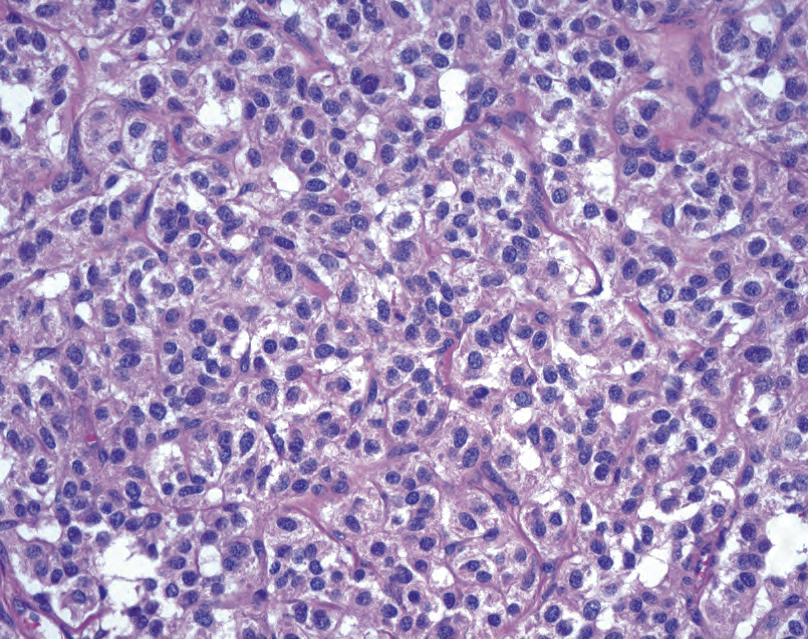
Figure 22.13. Carcinoid. This high-power view of an intrabronchial carcinoid shows a nested and trabecular pattern of cells with oval nuclei and typical “neuroendocrine” chromatin, meaning finely textured and speckled, without nucleoli or prominent nuclear membranes.
图22.13 类癌。支气管内类癌的高倍,细胞呈巢状和小梁状排列,卵圆形核和典型的“神经内分泌”染色质,即质地精细、点彩状,无核仁或明显核膜。
Atypical carcinoid: Atypical carcinoids are carcinoids with(1) increased mitoses, 2–10 per 10 high-power fields;(2) hyperchromatic nuclei; or(3) necrosis.
非典型类癌:与类癌相比:(1)核分裂增多,达到2-10个/10HPF;(2)核深染;或(3)坏死。
Small cell carcinoma: Small cell carcinoma is a high-grade neuroendocrine neoplasm with small cell morphology, including solid-to-trabecular-to-tubular patterns, hyperchromatic finely granular(denim-blue) nuclei, no nucleoli, syncytial appearance with nuclear molding, mitoses/apoptosis/necrosis, and streaming crush artifact(Figure 22.14). Small cell carcinoma may be found in combination with other carcinomas.
小细胞癌:高级别神经内分泌肿瘤,细胞小,实性到小梁状到管状形态,深染细颗粒性(牛仔布蓝)细胞核,无核仁,合胞体样伴核镶嵌,核分裂/凋亡/坏死和流水状挤压假象(图22.14)。小细胞癌可与其他癌并发。

Figure 22.14. Small cell carcinoma. Sheets of nuclei appear molded together with interlocking shapes due to the near absence of cytoplasm. The chromatin, like low-grade neuroendocrine neoplasms, is uniform and lacks nucleoli. Necrosis and mitoses(arrow) are common.
Salivary neoplasms: The seromucinous glands around the bronchi can give rise to any of the 图22.14 小细胞癌。由于几乎没有细胞质,成片的细胞核以交错的形状镶嵌在一起。像低级别神经内分泌肿瘤一样,染色质均匀,无核仁。常见坏死和核分裂(箭)。
Large cell neuroendocrine: A large cell neuroendocrine tumor is a high-grade neuroendocrine neoplasm with some neuroendocrine features, either architectural or nuclear, and positive neuroendocrine immunostains. Note that the “large cell” refers to the presence of cytoplasm, not larger nuclei per se.
大细胞神经内分泌肿瘤:高级别神经内分泌肿瘤,具有某些神经内分泌特征,包括结构或核,并且神经内分泌免疫染色阳性。注意,“大细胞”是指存在细胞质,而不是核本身更大。
Non-small cell carcinoma with neuroendocrine features: Per Rosai, this lesion looks like non–small cell by any criteria, but you happen to accidentally demonstrate that it is chromogranin positive.
非小细胞癌伴神经内分泌特征:根据Rosai的说法,这种病变用任何标准都符合非小细胞癌,但碰巧发现嗜铬素阳性。
其他病变(不完整列举)(Other Lesions(Incomplete Listing))
Hamartoma: A hamartoma is a tumor-like mass composed of a disorganized mixture of the normal elements found in that organ. It is not clonal and therefore not really a neoplasm. In the lung, these are often masses of cartilage, fat, smooth muscle, and epithelium.
错构瘤:肿瘤样肿块,由该器官中正常成分的无序混合物组成。它不是克隆性,因此不是真正的肿瘤。在肺中,这些肿瘤通常含有软骨、脂肪、平滑肌和上皮。
Salivary neoplasms: The seromucinous glands around the bronchi can give rise to any of the traditional salivary gland neoplasms.
涎腺型肿瘤:来自支气管周围的浆粘液腺,可发生任何传统类型的涎腺型肿瘤。
Carcinosarcoma: Carcinosarcoma is a truly biphasic malignant lesion, with a recognizable epithelial component(carcinoma) and a separate recognized form of sarcoma, such as osteosarcoma or chondrosarcoma. This is different from the sarcomatoid carcinoma, which is a pure carcinoma that has acquired spindle cell morphology.
癌肉瘤:是一种真正的双相恶性病变,具有可识别的上皮成分(癌)和单独的可识别的肉瘤形式,如骨肉瘤或软骨肉瘤。这与肉瘤样癌不同,肉瘤样癌是一种获得梭形细胞形态的纯粹的癌。
Pulmonary blastoma: Pulmonary blastoma is a form of carcinosarcoma in adults in which the epithelial component resembles fetal lung and the stromal component may be composed of adult-type sarcomas or immature mesenchymal tissue.
肺母细胞瘤:是一种成人发生的癌肉瘤,其上皮成分类似于胎儿肺,间质成分可能是成人型肉瘤或未成熟间充质组织。
Pleuropulmonary blastoma: Pleuropulmonary blastoma is an embryonal-type sarcoma of infancy, intrathoracic but often extrapulmonary, which may have cartilage and rhabdomyoblastic elements but not a carcinoma component.
胸膜肺母细胞瘤:是一种婴幼儿胚胎型肉瘤,位于胸腔内,但通常位于肺外,可能有软骨和横纹肌母细胞成分,但不是癌成分。
来源:
The Practice of Surgical Pathology:A Beginner’s Guide to the Diagnostic Process
外科病理学实践:诊断过程的初学者指南
Diana Weedman Molavi, MD, PhD
Sinai Hospital, Baltimore, Maryland
ISBN: 978-0-387-74485-8 e-ISBN: 978-0-387-74486-5
Library of Congress Control Number: 2007932936
© 2008 Springer Science+Business Media, LLC
仅供学习交流,不得用于其他任何途径。如有侵权,请联系删除。
本站欢迎原创文章投稿,来稿一经采用稿酬从优,投稿邮箱tougao@ipathology.com.cn
相关阅读
 数据加载中
数据加载中
我要评论

热点导读
-

淋巴瘤诊断中CD30检测那些事(五)
强子 华夏病理2022-06-02 -

【以例学病】肺结节状淋巴组织增生
华夏病理 华夏病理2022-05-31 -

这不是演习-一例穿刺活检的艰难诊断路
强子 华夏病理2022-05-26 -

黏液性血性胸水一例技术处理及诊断经验分享
华夏病理 华夏病理2022-05-25 -

中老年女性,怎么突发喘气困难?低度恶性纤维/肌纤维母细胞性肉瘤一例
华夏病理 华夏病理2022-05-07







共0条评论